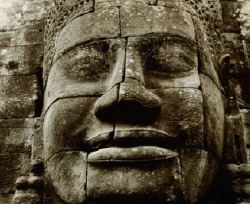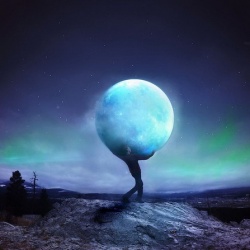Difference between revisions of "Rupa-skandha"
(Created page with "The aggregate of matter or form (Rupa) or Rupa-skandha. The aggregate of form corresponds to what we would call {{Wiki|material}} or physical f...") |
|||
| (6 intermediate revisions by the same user not shown) | |||
| Line 1: | Line 1: | ||
| + | [[File:Bayon.jpg|thumb|250px|]] | ||
| + | <poem> | ||
| + | [[FORM]] ([[Sanskrit]]: [[rupa]] – [[Tibetan]]: [[gzugs]]) | ||
| + | [[Skandha]] of [[Form]] means, that [[contact]] ([[Sanskrit]]: [[sparsa]]) occurs between {{Wiki|sensual}} {{Wiki|faculty}} ([[Sanskrit]]: [[indriya]], literally meaning [[power]]) and [[sense object]], whereby the {{Wiki|sensual}} {{Wiki|faculty}} is [[being]] disturbed and activated. This is how actual [[sensation]] happens. In the [[Dharma]], {{Wiki|sensual}} {{Wiki|faculty}} rather than the [[sense organ]] is described, because this is, what is {{Wiki|being}} [[experienced]], when someone [[meditating]] investigates, how [[sensation]] takes place in their own [[mind]]. There are 6 {{Wiki|sensual}} [[faculties]], corresponding to 6 kinds of [[sense objects]] and 6 kinds of [[sense-consciousness]] (read the column to the right). The 6th [[sense-consciousness]] is [[consciousness]] about the [[mind]]. More on that later. Each [[contact]] occurs separately from any other [[contact]] on this level, because each {{Wiki|sensual}} {{Wiki|faculty}} operates {{Wiki|independently}} from the others. All kinds of [[contact]] do in this way appear in some kind of [[form]] to the {{Wiki|sensual}} [[faculties]]. These [[forms]] are, what is seen, heard, tasted and so on. The [[sense objects]] may originate from the [[World]] or from the [[mind]] itself, for instance as [[dreams]]. [[Form]] is called {{Wiki|stimulus}} or {{Wiki|disturbance}}. [[Forms]] (or “matter”)(rūpa) - all {{Wiki|external}} and {{Wiki|internal}} [[matter]] is included here; according to [[philosophical]] [[definition]] the [[matter]] is what has a [[form]] and {{Wiki|colour}} | ||
| + | [[File:AtSzA.jpg|thumb|250px|]] | ||
The [[aggregate]] of [[matter]] or [[form]] ([[Rupa]]) or [[Rupa-skandha]]. The [[aggregate]] of [[form]] corresponds to what we would call {{Wiki|material}} or [[physical]] factors. It includes not only our own [[bodies]], but also the {{Wiki|material}} [[objects]] that surround {{Wiki|us}} - the [[earth, the]] oceans, the [[trees]], the buildings, and so forth. Specifically, the [[aggregate]] of [[form]] includes the five [[physical]] [[sense organs]] and the corresponding [[physical]] [[objects]] of the [[sense organs]]. These are the [[eyes]] and [[visible]] [[objects]], the {{Wiki|ears}} and [[sound]], the {{Wiki|nose}} and {{Wiki|smell}}, the {{Wiki|tongue}} and {{Wiki|taste}}, and the {{Wiki|skin}} and {{Wiki|tangible}} [[objects]]. | The [[aggregate]] of [[matter]] or [[form]] ([[Rupa]]) or [[Rupa-skandha]]. The [[aggregate]] of [[form]] corresponds to what we would call {{Wiki|material}} or [[physical]] factors. It includes not only our own [[bodies]], but also the {{Wiki|material}} [[objects]] that surround {{Wiki|us}} - the [[earth, the]] oceans, the [[trees]], the buildings, and so forth. Specifically, the [[aggregate]] of [[form]] includes the five [[physical]] [[sense organs]] and the corresponding [[physical]] [[objects]] of the [[sense organs]]. These are the [[eyes]] and [[visible]] [[objects]], the {{Wiki|ears}} and [[sound]], the {{Wiki|nose}} and {{Wiki|smell}}, the {{Wiki|tongue}} and {{Wiki|taste}}, and the {{Wiki|skin}} and {{Wiki|tangible}} [[objects]]. | ||
| − | But [[physical]] [[elements]] by themselves are not enough to produce [[experience]]. The simple [[contact]] between the [[eyes]] and [[visible]] [[objects]], or between the {{Wiki|ears}} and [[sound]] cannot result in [[experience]] without [[consciousness]] ([[Vijnana]]). The [[eyes]] can be in conjunction with the [[visible]] [[object]] indefinitely without producing [[experience]]. The {{Wiki|ears}} too can be exposed to [[sound]] indefinitely without producing [[experience]]. Only the co-presence of [[consciousness]] together with the [[sense organ]] and the [[object]] of the [[sense organ]] produces [[experience]]. In other words, it is when the [[eyes]], the [[visible]] [[object]] and [[consciousness]] come together that the [[experience]] of a [[visible]] [[object]] is produced. [[Consciousness]] is therefore an indispensable [[element]] in the production of [[experience]]. | + | But [[physical]] [[elements]] by themselves are not enough to produce [[experience]]. The simple [[contact]] between the [[eyes]] and [[visible]] [[objects]], or between the {{Wiki|ears}} and [[sound]] cannot result in [[experience]] without [[consciousness]] ([[Vijnana]]). The [[eyes]] can be in {{Wiki|conjunction}} with the [[visible]] [[object]] indefinitely without producing [[experience]]. The {{Wiki|ears}} too can be exposed to [[sound]] indefinitely without producing [[experience]]. Only the co-presence of [[consciousness]] together with the [[sense organ]] and the [[object]] of the [[sense organ]] produces [[experience]]. In other words, it is when the [[eyes]], the [[visible]] [[object]] and [[consciousness]] come together that the [[experience]] of a [[visible]] [[object]] is produced. [[Consciousness]] is therefore an indispensable [[element]] in the production of [[experience]]. |
| − | Before we go on to our [[consideration]] of the [[mental factors]] of personal [[experience]], I would like to mention briefly the [[existence]] of one more set of an {{Wiki|organ}} and its [[object]], and here I speak of the sixth-sense -the [[mind]]. This is in addition to the five [[physical]] [[sense organs]] - [[eyes]], {{Wiki|ears}}, {{Wiki|nose}}, {{Wiki|tongue}} and {{Wiki|skin}}. Just as the five [[physical]] [[sense organs]] have their corresponding [[physical]] [[objects]], the [[mind]] has for its [[object]] [[ideas]] or properties ([[dharmas]]). And as in the case of the five [[physical]] [[sense organs]], [[consciousness]] is present to unite the [[mind]] and its [[object]] so as to produce [[experience]]. | + | Before we go on to our [[consideration]] of the [[mental factors]] of personal [[experience]], I would like to mention briefly the [[existence]] of one more set of an {{Wiki|organ}} and its [[object]], and here I speak of the sixth-sense -the [[mind]]. This is in addition to the five [[physical]] [[sense organs]] - [[eyes]], {{Wiki|ears}}, {{Wiki|nose}}, {{Wiki|tongue}} and {{Wiki|skin}}. Just as the five [[physical]] [[sense organs]] have their corresponding [[physical]] [[objects]], the [[mind]] has for its [[object]] [[ideas]] or properties ([[dharmas]]). And as in the case of the five [[physical]] [[sense organs]], [[consciousness]] is {{Wiki|present}} to unite the [[mind]] and its [[object]] so as to produce [[experience]]. |
Let {{Wiki|us}} now look at the [[mental factors]] of [[experience]] and let {{Wiki|us}} see if we can understand how [[consciousness]] turns the [[physical]] factors of [[experience]] into personal [[conscious]] [[experience]]. First of all, we must remember that [[consciousness]] is mere [[awareness]], or mere sensitivity to an [[object]]. When the [[physical]] factors of [[experience]], as for example the [[eyes]] and a [[visible]] [[object]], come into [[contact]], and when [[consciousness]] too becomes associated with the [[physical]] factors of [[experience]], [[visual consciousness]] arises. This is mere [[awareness]] of a [[visible]] [[object]], not anything like what we could call personal [[experience]]. The way that our personal [[experience]] is produced is through the functioning of the other three major [[mental factors]] of [[experience]] and they are the [[aggregate]] of [[feeling]], the [[aggregate]] of [[perception]] and the [[aggregate]] of [[mental formation]] or [[volition]]. These three [[aggregates]] [[function]] to turn this mere [[awareness]] of the [[object]] into personal [[experience]]. | Let {{Wiki|us}} now look at the [[mental factors]] of [[experience]] and let {{Wiki|us}} see if we can understand how [[consciousness]] turns the [[physical]] factors of [[experience]] into personal [[conscious]] [[experience]]. First of all, we must remember that [[consciousness]] is mere [[awareness]], or mere sensitivity to an [[object]]. When the [[physical]] factors of [[experience]], as for example the [[eyes]] and a [[visible]] [[object]], come into [[contact]], and when [[consciousness]] too becomes associated with the [[physical]] factors of [[experience]], [[visual consciousness]] arises. This is mere [[awareness]] of a [[visible]] [[object]], not anything like what we could call personal [[experience]]. The way that our personal [[experience]] is produced is through the functioning of the other three major [[mental factors]] of [[experience]] and they are the [[aggregate]] of [[feeling]], the [[aggregate]] of [[perception]] and the [[aggregate]] of [[mental formation]] or [[volition]]. These three [[aggregates]] [[function]] to turn this mere [[awareness]] of the [[object]] into personal [[experience]]. | ||
| + | </poem> | ||
{{R}} | {{R}} | ||
[http://www.buddhanet.net/funbud14.htm www.buddhanet.net] | [http://www.buddhanet.net/funbud14.htm www.buddhanet.net] | ||
| − | [[Category: | + | |
| + | [[Category:Rupa-skandha]] | ||
Latest revision as of 23:55, 29 October 2014
FORM (Sanskrit: rupa – Tibetan: gzugs)
Skandha of Form means, that contact (Sanskrit: sparsa) occurs between sensual faculty (Sanskrit: indriya, literally meaning power) and sense object, whereby the sensual faculty is being disturbed and activated. This is how actual sensation happens. In the Dharma, sensual faculty rather than the sense organ is described, because this is, what is being experienced, when someone meditating investigates, how sensation takes place in their own mind. There are 6 sensual faculties, corresponding to 6 kinds of sense objects and 6 kinds of sense-consciousness (read the column to the right). The 6th sense-consciousness is consciousness about the mind. More on that later. Each contact occurs separately from any other contact on this level, because each sensual faculty operates independently from the others. All kinds of contact do in this way appear in some kind of form to the sensual faculties. These forms are, what is seen, heard, tasted and so on. The sense objects may originate from the World or from the mind itself, for instance as dreams. Form is called stimulus or disturbance. Forms (or “matter”)(rūpa) - all external and internal matter is included here; according to philosophical definition the matter is what has a form and colour
The aggregate of matter or form (Rupa) or Rupa-skandha. The aggregate of form corresponds to what we would call material or physical factors. It includes not only our own bodies, but also the material objects that surround us - the earth, the oceans, the trees, the buildings, and so forth. Specifically, the aggregate of form includes the five physical sense organs and the corresponding physical objects of the sense organs. These are the eyes and visible objects, the ears and sound, the nose and smell, the tongue and taste, and the skin and tangible objects.
But physical elements by themselves are not enough to produce experience. The simple contact between the eyes and visible objects, or between the ears and sound cannot result in experience without consciousness (Vijnana). The eyes can be in conjunction with the visible object indefinitely without producing experience. The ears too can be exposed to sound indefinitely without producing experience. Only the co-presence of consciousness together with the sense organ and the object of the sense organ produces experience. In other words, it is when the eyes, the visible object and consciousness come together that the experience of a visible object is produced. Consciousness is therefore an indispensable element in the production of experience.
Before we go on to our consideration of the mental factors of personal experience, I would like to mention briefly the existence of one more set of an organ and its object, and here I speak of the sixth-sense -the mind. This is in addition to the five physical sense organs - eyes, ears, nose, tongue and skin. Just as the five physical sense organs have their corresponding physical objects, the mind has for its object ideas or properties (dharmas). And as in the case of the five physical sense organs, consciousness is present to unite the mind and its object so as to produce experience.
Let us now look at the mental factors of experience and let us see if we can understand how consciousness turns the physical factors of experience into personal conscious experience. First of all, we must remember that consciousness is mere awareness, or mere sensitivity to an object. When the physical factors of experience, as for example the eyes and a visible object, come into contact, and when consciousness too becomes associated with the physical factors of experience, visual consciousness arises. This is mere awareness of a visible object, not anything like what we could call personal experience. The way that our personal experience is produced is through the functioning of the other three major mental factors of experience and they are the aggregate of feeling, the aggregate of perception and the aggregate of mental formation or volition. These three aggregates function to turn this mere awareness of the object into personal experience.

